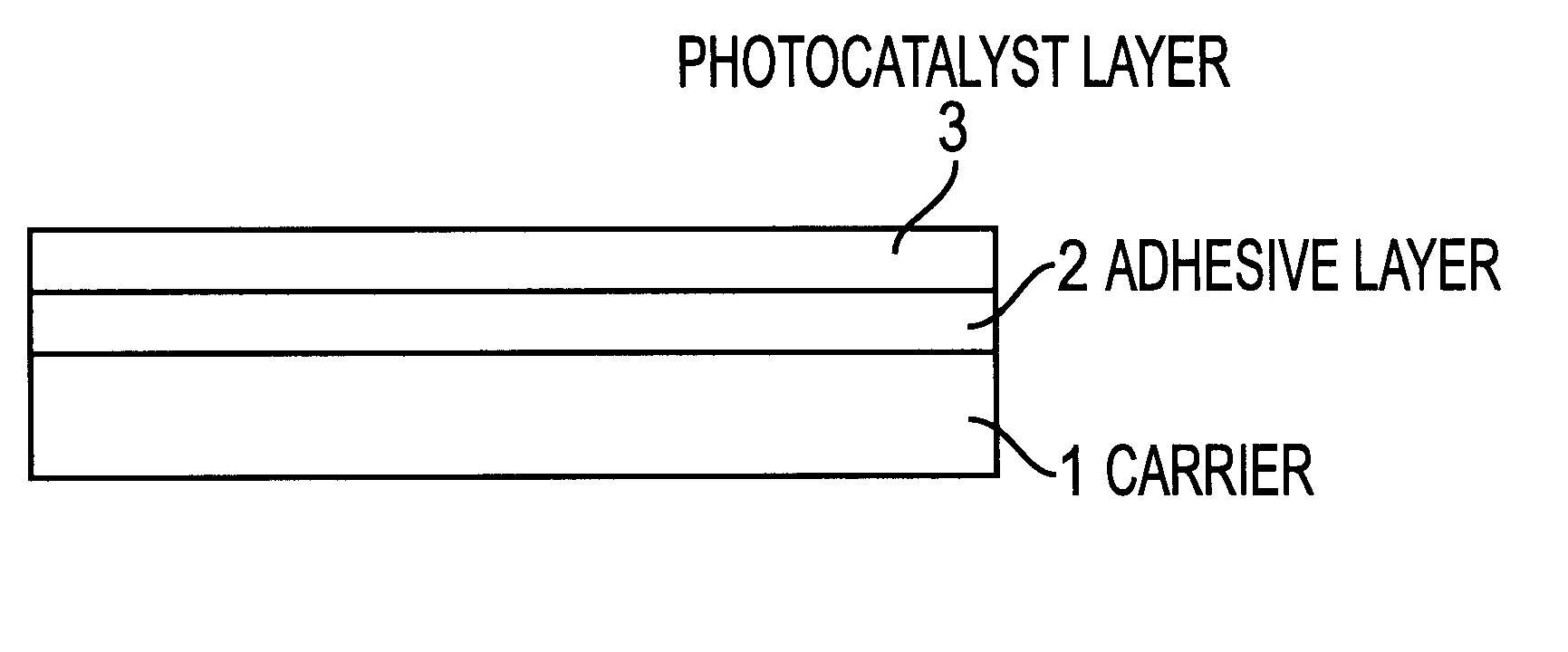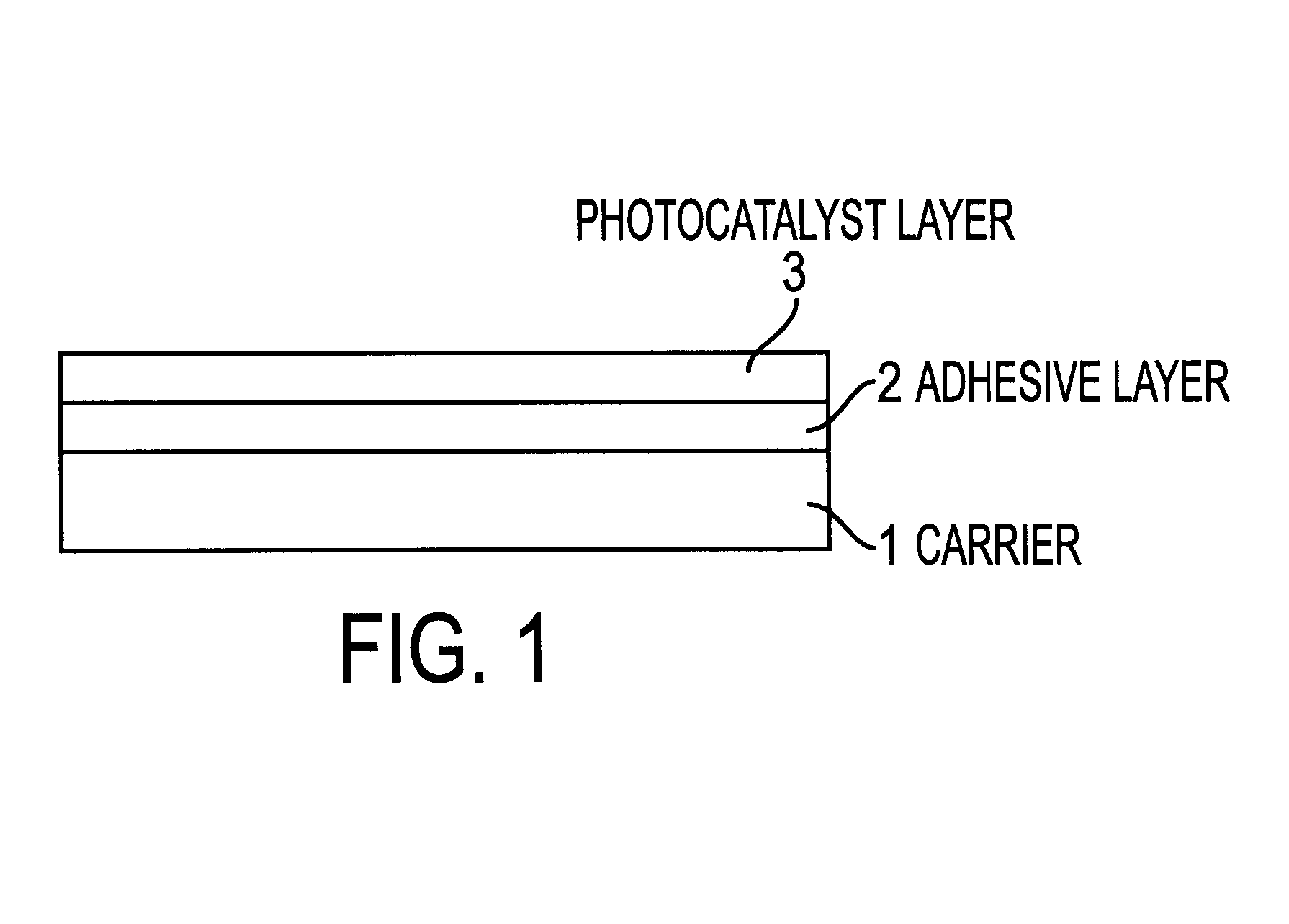Photocatalyst-carrying structure and photocatalyst coating material
a photocatalyst and coating material technology, applied in the direction of organic compound/hydride/coordination complex catalyst, physical/chemical process catalyst, metal/metal-oxide/metal-hydroxide catalyst, etc., can solve the problems of reducing photocatalytic activity, deteriorating, and affecting the durability of organic materials, so as to improve the adhesive property of the adhesive layer, excellent durability, and the effect of photocatalytic activity
- Summary
- Abstract
- Description
- Claims
- Application Information
AI Technical Summary
Benefits of technology
Problems solved by technology
Method used
Image
Examples
example 19
Use of Titania Sol
A coating material to be used for forming a photocatalyst layer was prepared by adding and dispersing titania sol containing 12% by weight of titanium dioxide and acidified with nitric acid, which is a substitute of fine granule titanium dioxide (P-25) manufactred by Nihon Aerozil Co., Ltd., into silica gel (Trade name: Cataloid SI-30, Manufactured by Shokubai Kasei Co., Ltd.) being adjusted to pH 1.5 and then further adding a surfactant. Whereas, a solution to be used for an adhesive layer was prepared by adding polymethoxy siloxane (PS-2) into a resin solution used in the example 10 at a rate such that the content of silicon oxide in a dried adhesive layer becomes 35% by weight.
The solution for forming an adhesive layer was applied by using a baker applicator onto a soda lime glass substrate with a thickness of 1 mm and a dimension of 7 cm.times.7 cm, and the coating material for forming a photocatalyst layer was also applied by using bar coater onto the same sub...
example 20
A photocalyst-carrying structure was prepared by using the same materials and according to the same method as described in the example 19 except replacing silica sol used in the example 19 with a mixed sol solution consisting of alumina sol manufactured by Nissan Chemical Industries Co., Ltd. and silica sol.
The photocatalyst-carrying structure obtained was found to have high adhesive property and photocatalytic activity.
example 21
Coating According to Gravure Printing Method
By using gravure printing system, the solution for forming an adhesive layer and the solution for forming a photocatalyst layer were applied onto a polyester film (Trade name: Cosmoshine A4100) manufactured by Toyobo Co., Ltd. at a speed of 10 m / min. and at dry zone temperature of 130.degree. C. such that the thickness of each layers become 3 .mu.m, respectively. For the printing, a microgravure coater with a width of 70 cm manufactured by Yasui Seiki Co., Ltd. was used.
The photocatalyst-carrying structure obtained was found to have very high whole light transmittance of 95%.
PUM
| Property | Measurement | Unit |
|---|---|---|
| Percent by mass | aaaaa | aaaaa |
| Percent by mass | aaaaa | aaaaa |
| Percent by mass | aaaaa | aaaaa |
Abstract
Description
Claims
Application Information
 Login to View More
Login to View More - R&D
- Intellectual Property
- Life Sciences
- Materials
- Tech Scout
- Unparalleled Data Quality
- Higher Quality Content
- 60% Fewer Hallucinations
Browse by: Latest US Patents, China's latest patents, Technical Efficacy Thesaurus, Application Domain, Technology Topic, Popular Technical Reports.
© 2025 PatSnap. All rights reserved.Legal|Privacy policy|Modern Slavery Act Transparency Statement|Sitemap|About US| Contact US: help@patsnap.com


